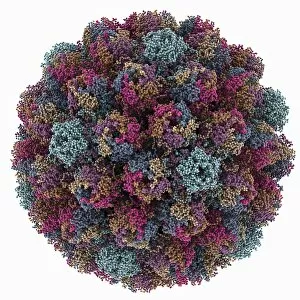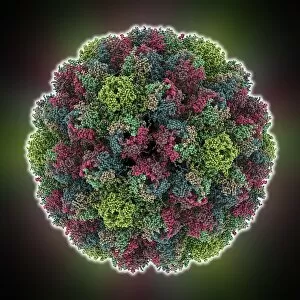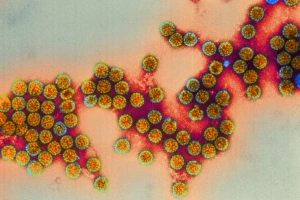Oncogenic Collection
"Unveiling the Intricate World Viruses
All Professionally Made to Order for Quick Shipping
"Unveiling the Intricate World Viruses: A Visual Journey into Polyomaviruses and SV40" Step into the captivating realm viruses with these stunning conceptual images and molecular models. The polyomavirus, a group of DNA viruses, takes center stage as we explore its diverse forms. The first set of conceptual images showcases the intricate structure of the polyomavirus. With their symmetrical patterns and mesmerizing shapes, they offer a glimpse into the hidden world where these tiny agents wreak havoc on cellular machinery. Moving forward, our attention shifts to specific types within the polyomavirus family. Behold the murine polyomavirus capsid, revealing its unique features that enable it to infect mice. Its counterpart, avian polyomavirus capsid, presents an equally fascinating design tailored for bird hosts. But our exploration doesn't stop there - enter SV40 virus capsids. These molecular models provide detailed insights into this infamous oncogenic virus known for its association with cancer in humans. Molecular model F006/9508 highlights key structural elements while showcasing SV40's complexity. Intriguingly shaped yet potentially dangerous, SV40's molecular model captures our imagination once again. This time it is presented without labels (molecular model) allowing us to appreciate its aesthetic appeal while pondering over its detrimental effects on human health. Lastly, we encounter another variant through molecular model C018/7904 - an alternative perspective that further deepens our understanding of how different strains can impact cellular processes differently. Through this visual journey encompassing various forms and structures related to oncogenic viruses like polyomaviruses and SV40, we gain a newfound appreciation for their complex nature and potential implications in disease development. Let these captivating visuals inspire curiosity about viral mechanisms driving tumorigenesis as scientists continue unraveling their mysteries in pursuit of effective treatments against cancer.









